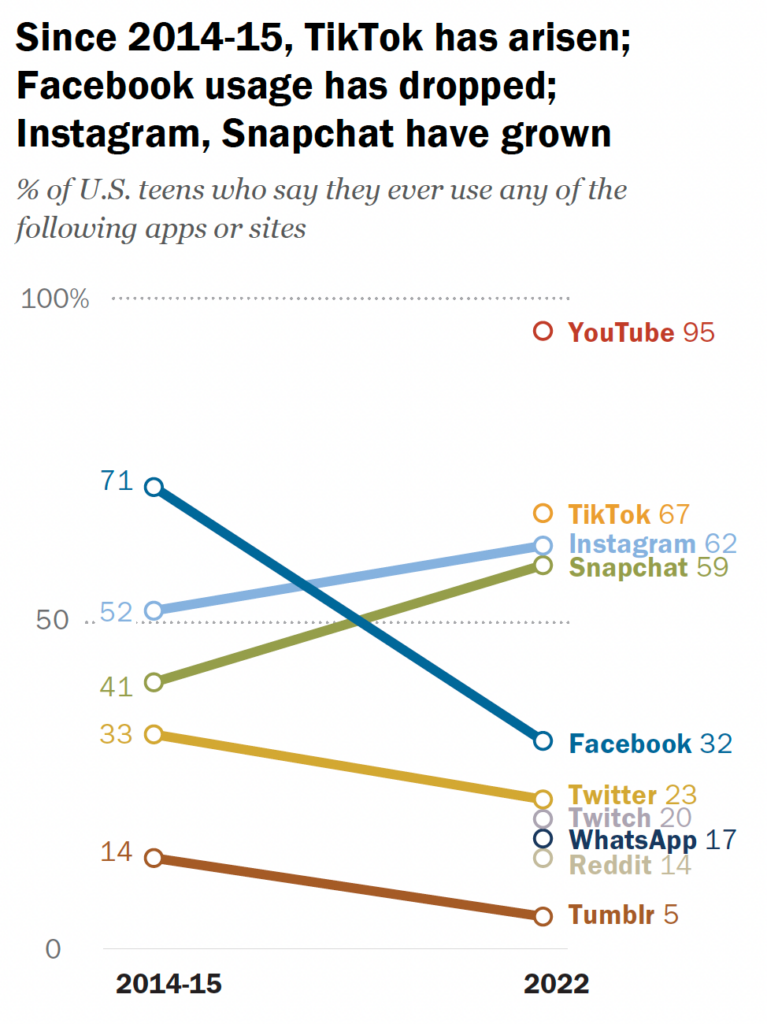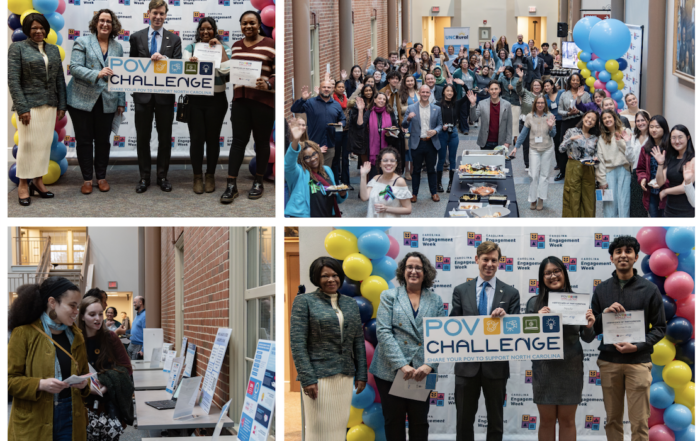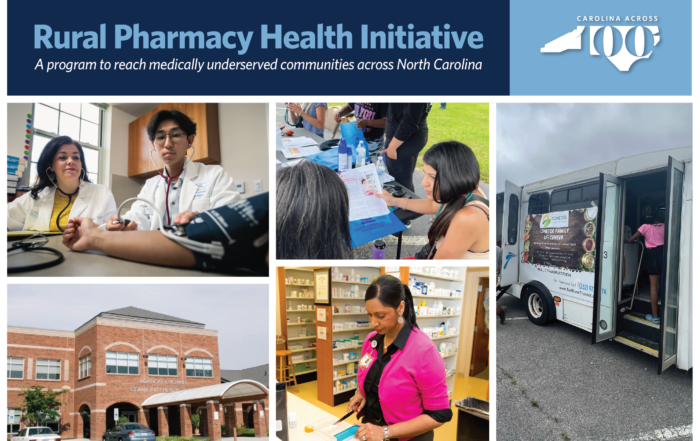Learnings
Designing Effective Outreach for Youth
by Olivia Allison and Gisella Lie (UNC MPH Program)
May 10, 2023

When you spot a young person out and about, it’s more than likely they’ll be on their phone. In 2022, 95% of youth ages 13 to 17 had access to a smartphone and 97% used the internet daily. It’s also likely that those phones are being used to scroll social media, with certain platforms leading the way in terms of popularity among this population – YouTube (97%), TikTok (67%), and Instagram (60%).
 In addition to tracking platform usage and trends over time, some research also investigates preferences for content type. For instance, one study found that youth preferred social media posts that showcase local youth and their accomplishments. Youth engaged more with posts that showed program activities, such as career workshops and internships. Social media can be a more cost-effective outreach strategy to reach a specific audience compared to traditional, in-person outreach. Conventional means of outreach are limited by physical and geographical spaces, but social media offers a way to overcome these boundaries. Social media increases an organization’s reach to people who are traditionally hard to access.
In addition to tracking platform usage and trends over time, some research also investigates preferences for content type. For instance, one study found that youth preferred social media posts that showcase local youth and their accomplishments. Youth engaged more with posts that showed program activities, such as career workshops and internships. Social media can be a more cost-effective outreach strategy to reach a specific audience compared to traditional, in-person outreach. Conventional means of outreach are limited by physical and geographical spaces, but social media offers a way to overcome these boundaries. Social media increases an organization’s reach to people who are traditionally hard to access.
This research suggests that social media can be a powerful tool for organizations aiming to reach young people, but how do they best leverage this opportunity? The Carolina Across 100 team explored this topic in a recent webinar with the community collaborative teams taking part in the Our State, Our Work program which aims to expand pathways to living wage employment for Opportunity Youth (people ages 16-24 who are not working and not in school). Following the webinar, the team summarized the content in a blog post, Social Media Advice for Community Organizations, and offered multiple resources for utilizing social media. This blog continues the topic of social media, offers some additional considerations for outreach methods, and provides design tips, regardless of the format or platform.
Caveats of social media
Despite an explosion of social media usage over the last decade, youth do not always trust the information they are shown and they sometimes seek out other sources. For instance, several youth from the focus groups conducted by ncIMPACT Initiative and NCGrowth indicated that they worry about scams on social media.
In Onslow County, a young person discussed the concern with being scammed on social media:
“I would just scroll down. Because I know hackers put ads, and if you click the link, they have your phone. I have some IT skills and I know how it works. I would prefer to scroll down because of the danger of the hackers.”
While some young people do obtain resources and information from social media, youth in the focus groups discussed how they are more likely to get information from traditional outreach such as flyers or from trusted individuals. One young person from Franklin County said:
“For me personally, I kind of just scroll past ads on social media. So, unless it’s something that person is super interested in, it’s also really hard to reach them with the algorithms that social media uses. But flyers and billboards [are] a really good way to reach me personally because I pay attention to them.”
Social media is an important tool for engaging youth and for potentially having a further geographic reach, but traditional outreach methods can be useful as well. It is recommended to use social media and traditional methods in tandem for the most effective outreach. For example, an organization could take an infographic created for a social media post and print it as flyers to be posted in the community. It is important for organizations to consider the community they are targeting when planning outreach strategies to be most effective in reaching the intended audience.
Design Matters
When creating content for social media or for traditional media, good design is non-negotiable. The primary purpose of design (specifically graphic design in this context) is for communication. Good design means effective communication. No matter who the target audience is, following fundamental design principles will always be valuable. However, there are several things to consider when designing for the younger generation:
A 2020 study by Murchie and Diomede showcased fundamental principles of graphic design. In the world messages and content come faster than we can keep up, good design will attract and retain people’s attention. The paper broke down effective design to four elements: layout, imagery, typeface & fonts, and color.
Layout
Layout is the foundation for a design that affects how the audience can effectively process a material. A disorganized, messy layout requires more brain energy to process. Hence, the first step is to decide which information is the most important to be conveyed. When it comes to putting things in layout, there are two main suggestions:
- Keep things in a grid in a logical manner.
- When in doubt, always keep things simple. Trim all elements until you are down to the most important information.
When information is easier to process, people will be more willing to engage and information will be more memorable. Content must be short, to the point, and quickly understood.
Imagery
A picture is worth a thousand words, but it will be more powerful (and memorable) when a picture is accompanied by appropriate text. To have effective imagery, knowing your priority audience is important. For example, if reaching out to communities of color, using an all-white stock photo will not be effective or appropriate.
Images can help illustrate a point and need to be used effectively. Rules of thumb: always use high-quality images that are sharp, clear, and distinct. If possible, avoid using any clip art or stock photos to show more authenticity. Using photos from your organization’s previous activities is an alternative option.

Typefaces and Fonts
Choosing the right typeface and font is also crucial as this sets the tone of the message and information that you’re trying to deliver. Some typefaces (such as Comic Sans) do not reflect seriousness and may come as playful or even unprofessional. Using a serif typeface (like Times New Roman) may cause illegibility issues as it is more tightly put together. Legibility is an important aspect of outreach flyers that will be put in high-volume areas. Once you have created content, consider the legibility and whether the information is emphasized as intended. Bolding certain information, such as the date and time, will signal to the brain that it is important information.
Color
Color is an important communication tool that can draw attention, evoke emotion, and communicate action. Due to human nature, certain messages may have been assigned to certain colors (red is anger, blue is sadness). but it is important to understand that this is highly dependent on culture (red is symbolic of luck in many Asian cultures). Hence, it is once again important to understand your priority population.
Color, like typeface and font, can be used to emphasize hierarchy and showcase important information. It is also important to consider the practical use of color since it can affect legibility. If you’re going to print it out, will it come out nicely in print? How about people that are color-blind?

The Bottom Line
To create flyers or social media content, you don’t need an in-house graphic designer. However, if you feel that your visual communication has not been effective, it is wise to consult a graphic designer anyway. Whether you decide to start utilizing social media for outreach or stick to traditional methods, good design is crucial to deliver effective communication and attract the priority audience. When in doubt, don’t forget to keep it simple!
Carolina Across 100 is a five-year initiative whose goal is to aid community-driven recovery and build sustainable efforts in all 100 counties by providing human resources, data insights, coaching, facilitation, coordination efforts, and program design.






